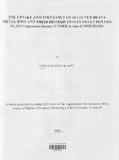| dc.description.abstract | Some heavy metals are essential while others may adversely affect human who are water and plant
consumers. Pollution by heavy metals is a major problem globally and hence the need to identify
sources of the metals and explore effective, yet low cost methods for environmental remediation.
Phytoremediation is one such method, which involves uptake and degradation of organic and
inorganic pollutants by plants from soil and groundwater. In case of inorganic, such as heavy
metals, phytoremediation involves uptake and sequestration of these metals in foliage for easier
disposal. Selected plants can therefore be used to restore environment contaminated with
pollutants.
This research study aimed at investigating the extent to which locally available sweet potato plant
varieties (Ipomoea batatas) absorbed and translocated cadmium, zinc, lead and chromium from
their respective heavy metal-containing solutions of known concentrations. The influence of the
sweet potato plant varieties in the electrical conductivity, pH and temperature of the heavy metalcontaining
solutions in which they were immersed was monitored during the experimental period.
The study was also investigated the tolerance of the plants in varying concentrations of heavy
metal-containing solutions.
Five sweet potato varieties namely UP-A, UP-B, UP-C, UP-D and UP-16 were used in the study.
The plant cuttings of the size 15-20cm of the plant varieties were obtained from the garden at the
University of Nairobi, College of Biological and Physical Sciences (CBPS). Their leaves were
removed and then pre-rooted in large open plastic containers containing tap water for 30 days. The
cuttings developed new leaves and roots. Stock solutions of 1000ppm cadmium, zinc lead and
chromium were prepared from their respective soluble salts using distilled water and further
diluted into working solutions of concentrations 10ppm, 20ppm and 50ppm. Distilled water was
used as a control in this work. The already pre-rooted plants were then immersed in distilled water
and the heavy metal-containing solutions and monitored for 14-21 days.
While there were no significant changes in pH and temperature of the solutions over the
experimental period, the electrical conductivity of the heavy metal-containing solutions of
cadmium, zinc and chromium with immersed sweet potato plant varieties increased over the
experimental period compared to those without the plant varieties. However, the electrical
conductivity of lead-containing solutions increased for the first week and then reduced towards the
end of the experimental period ..
The extent to which the heavy metals were absorbed and translocated from the heavy metalcontaining
solutions into the plant roots, stem and leaves was analysed using Atomic Absorption
Spectroscopy technique. The dry plant tissues were acid digested for metal ion analysis. The
degree of uptake varied with the concentration of the metal solution and the dry weight of the
tissues. It was observed that in almost all the plant varieties, the roots registered higher amounts of
the heavy metals followed by the stem and the leaves Cadmium content obtained from sweet potato plant varieties immersed in IOppm cadmium-a containing solutions ranged from 653.51 ug to 77l.52 ug of dry weight while that from 20ppm W containing solutions ranged from 653.51 solution ranged from 920.18 ug to1032.70 ug of total dry weight. Results of zinc content in the plant varieties immersed in 10ppm zinc-containing solutions gave the range of361.38 ug to 499.79 ug per dry weight and 505.44 ug to 60l.67 ug per dry weight for plants immersed in 20ppm zinccontaining solution. However lower range of between 308.63 ug and 370.42 ug of dry weight was recovered from plants immersed in 50ppm zinc-containing solution. Plant varieties immersed in
lead-containing solutions registered the highest lead content compared to the other metals used for
the study. The plants immersed in IOppm lead-containing solution accumulated a range of7.14 ug
to 108.1Ougof lead per dry weights while the plants immersed in 20ppm lead-containing solution
gave a range of 1389.41 ug to 1962.13 ug lead per dry weight. Plant varieties immersed in 50ppm
solution had lead content of between 2.80mg and 3.57mg per mean dry weight. Plants immersed in
chromium-containing solutions however, showed lower contents compared with those immersed in
10ppm total chromium-containing solution giving a range of 109.23Jlg to 164.64Jlg of dry weight
while the plants immersed in 20ppm cadmium-containing solution ranged from 159.13ug to
240.7Jlg per dry weight. Total chromium content of the plants harvested from 50ppm solution
ranged from 341.49Jlg to 685.69Jlg of dry weight.
From the results it was concluded that sweet potato plants can actually take up
cadmium, zinc lead
and chromium and distribute them in the different parts of the plants. The plants can be used to
remediate heavy metal contaminated sites. The amount of each heavy metal in the roots, stem and
leaves increased with the increase of its ions in the solutions. However, the percentage of the
metals in each part of the sweet potato plant variety decreased with the increase in metal ions in
the solutions an observation attributed to possible toxicity of heavy metal to plants. The variations
in metal ions uptake by different varieties could not be fully explained.
The recommendations made inciude a detailed study of adsorption of the heavy metal ions on the
surface of the roots and the stem of the sweet potato plants should be carried out to provide data. A
study of the absorption and translocation paths of the metals in the plant tissues should also be
carried out. This study may help in explaining the transport path ways of different metal ions in the
sweet potato plant tissues. Further research of the extent of accumulation of these metals in the sweet potato tubers obtained from contaminated sites is recommended. This will help the
consumers of the tuber against consuming sweet potato tubers and leaves obtained from heavy
metals contaminated sites. After the use of the sweet potato plant in phytoremediation process, the
next challenge is to find out the safest way of disposing the vines in order to avoid more
contamination. A study to this effect is therefore recommended. | en |

